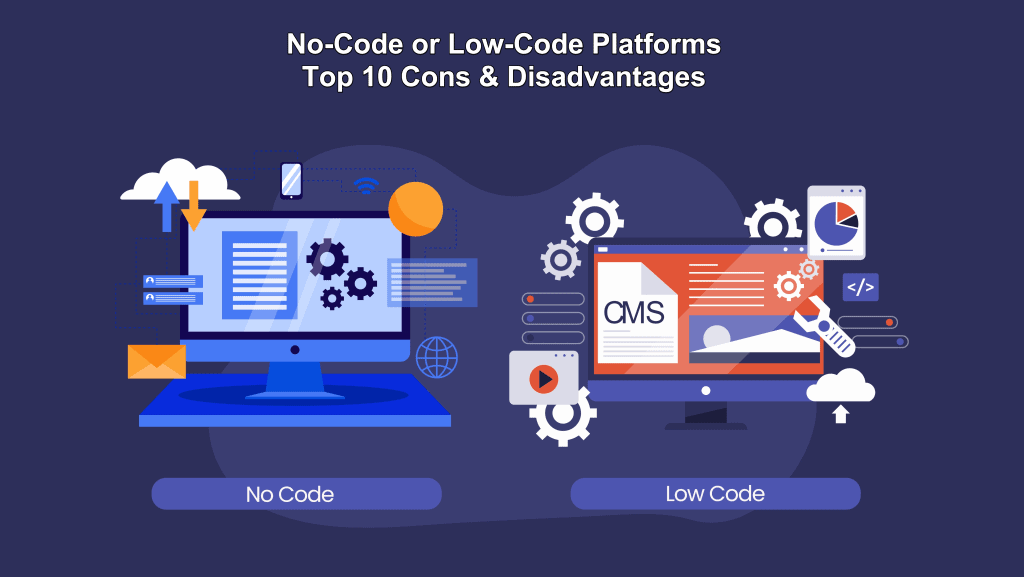Top 10 Cons & Disadvantages of Low-Code No-Code Platforms

No-code platforms have emerged as a popular means for businesses and individuals to create applications without the need for traditional coding skills. They offer an accessible gateway to technology development, allowing users to build custom software through graphical user interfaces and configuration instead of writing code. However, while these platforms have democratized software development, they have inherent limitations and challenges. Understanding these limitations is crucial to making informed decisions about when and how to use no-code solutions effectively.
The increasing demand for digital solutions across various sectors has driven the rise of low-code platforms. They enable rapid deployment of applications, making it easier for non-technical users to contribute to the digital landscape. Despite these benefits, the drawbacks of low-code platforms cannot be overlooked. Issues ranging from limited customization and scalability to security concerns have become significant roadblocks. In this context, it is essential to explore the disadvantages of using low-code platforms, especially for businesses and developers looking to maximize the potential of their digital assets.
No-Code or Low-Code Platforms: Top 10 Cons & Disadvantages
When discussing the top ten cons and disadvantages of no-code platforms, it’s essential to consider various factors. While beneficial for quick deployment and ease of use, these platforms often suffer from flexibility, scalability, and long-term viability issues. Each of these disadvantages impacts different aspects of software development and deployment, from the initial design phase to the maintenance and updating of the application. This section aims to provide a comprehensive overview of these critical drawbacks, offering insights into why and how they might affect your projects.
1. Limited Customization
One of the primary drawbacks of low-code platforms is their limited customization options. For instance, a small business might use a low-code platform to set up an online store quickly but soon find it doesn’t support specific payment options or unique checkout processes crucial for their business model. This limitation stems from the fact that low-code platforms offer a set of predefined components and templates, which restricts the ability to tailor applications to specific needs. Users often find themselves confined within the boundaries of what the platform can offer, unable to implement unique or complex functionalities.
To mitigate this issue, no-code platforms could integrate more flexible modules and offer APIs for custom development. This approach would allow users to enjoy the simplicity of no-code development while having the option to incorporate custom features through code as needed.
2. Scalability Concerns
Low-code platforms often struggle with scalability, especially for larger projects or those with growing user bases. Take the example of a startup that initially used a low-code solution for its customer relationship management system. As the company grows, the system may not effectively handle increased data volumes or complex business processes. This scalability issue arises because low-code platforms are generally designed for simplicity and ease of use, not for handling large-scale, complex operations.
To address scalability, no-code platforms need to offer more robust back-end infrastructure and the ability to integrate with other systems and databases seamlessly. This would enable users to scale their applications per their growth and evolving requirements.
3. Over-Reliance on Vendor
Using low-code platforms often leads to an over-reliance on the vendor for support, updates, and maintenance. A notable example is when a company’s critical application is built on a low-code platform, and the vendor decides to update the platform or change its pricing model. Such changes can significantly disrupt the business operation, leaving users at the mercy of the vendor’s decisions. This dependency can be risky, especially if the platform ceases operation or drastically alters its services.
To reduce this dependency, businesses should ensure that they have contingency plans, such as the ability to export their data and applications to other platforms or convert them into a more traditional codebase if needed. Additionally, selecting a platform with a strong reputation and commitment to customer support can mitigate some of these risks.
4. Security and Compliance Issues
Security is a significant concern with no-code platforms, particularly for sensitive data applications. For example, a healthcare provider using a no-code platform to manage patient records might face serious security and compliance issues, given the stringent regulations in the healthcare industry. No-code platforms often have limited options for customizing security settings, which can lead to vulnerabilities and non-compliance with industry standards.
To overcome these security challenges, no-code platform providers must enhance their security features and offer more robust compliance tools. Users should also be vigilant about the platform’s security certifications and compliance with relevant regulations.
5. Lack of Control Over Hosting and Data
Users of no-code platforms often have little control over where their applications are hosted and how their data is managed. This can be problematic for businesses with specific hosting requirements or those concerned about data sovereignty. For instance, a company operating in the European Union might need to ensure that its data is stored within the EU to comply with GDPR. However, if the no-code platform hosts the data outside the EU, this could lead to compliance issues.
To address this disadvantage, no-code platforms should offer more flexibility in hosting options, including the ability to choose data centers in specific regions. Users should also know the platform’s hosting policies and ensure they align with their legal and operational requirements.
6. Integration Limitations
No-code platforms often face limitations when integrating with other systems and tools. This becomes a disadvantage when businesses need to connect their no-code applications with existing enterprise systems, databases, or third-party services. For example, a company may use a no-code platform to build a customer feedback tool but find integrating it with its existing customer relationship management (CRM) system challenging. This lack of integration capability can lead to data silos and inefficient workflows.
No-code platforms should offer more robust APIs and integration options to overcome integration challenges and allow seamless connectivity with a wide range of systems and services. Users should also evaluate a platform’s integration capabilities before committing to it, ensuring it meets their specific needs.
7. Limited Expertise and Support
The ease of use of low-code platforms can lead to a lack of deep technical expertise among users, which becomes evident when complex issues arise. For instance, a marketing team might build a campaign management tool using a low-code platform but struggle to troubleshoot problems or optimize performance due to their limited technical knowledge. This lack of expertise can significantly hinder resolving complex issues beyond the platform’s standard support scope.
To address this, low-code platforms must provide comprehensive support and resources, including detailed documentation, community forums, and access to technical experts. Users should also consider investing in training or consulting services to build internal expertise and ensure they can effectively manage and optimize their low-code applications.
8. Limited Performance Optimization
Performance optimization is often challenging with no-code platforms, particularly for applications with high user traffic or data processing requirements. An example of this issue is an e-commerce website built on a no-code platform that experiences slow loading times during peak traffic, leading to a poor user experience and potential loss of sales. No-code platforms typically offer limited options for optimizing performance, such as adjusting server resources or fine-tuning the application’s architecture.
To mitigate performance issues, no-code platforms should improve their infrastructure and offer users more control over performance settings. Additionally, users should carefully evaluate the performance capabilities of a no-code platform before building critical applications, especially those expected to handle high traffic or complex processes.
9. Limited Learning and Skill Development
While low-code platforms are accessible to non-technical users, they can also limit learning and skill development in traditional coding and software development. For example, a business analyst using a low-code tool to build reports and dashboards might miss out on learning SQL or Python, which could be valuable skills in their career. This limitation can hinder professional growth and leave users reliant on specific platforms without a deeper understanding of underlying technologies.
To counteract this, individuals and organizations should balance using low-code tools with opportunities for learning and development in more traditional coding and software engineering practices. This approach ensures a more well-rounded skill set and greater flexibility in tackling various technical challenges.
10. Difficulty in Handling Complex Logic
No-code platforms often struggle with implementing complex logic and algorithms, a significant limitation for applications requiring advanced data processing or decision-making capabilities. For instance, a logistics company might find it challenging to build a sophisticated route optimization tool using a no-code platform due to its inability to handle complex algorithms and conditional logic effectively. This limitation can restrict the types of applications that can be built and reduce the solution’s overall effectiveness.
To overcome this limitation, no-code platforms should strive to incorporate more advanced logic capabilities and allow for custom code integration where necessary. Users should also evaluate the platform’s ability to handle complex logic before embarking on projects that require such capabilities.
How Could These Disadvantages be Overcome?
Overcoming the disadvantages of low-code platforms requires a multifaceted approach involving both technological advancements and strategic planning. By addressing these shortcomings, low-code platforms can become more robust, versatile, and suitable for a broader range of applications.
- Enhanced Customization and Flexibility: Integrating advanced customization options and allowing for the addition of custom code can significantly improve the adaptability of low-code platforms.
- Improved Scalability: Upgrading infrastructure to support scaling and offering options for seamless integration with other systems can help manage growth more effectively.
- Diversified Hosting Options: Providing flexibility in data hosting, including options for on-premises and region-specific cloud hosting, can address data sovereignty and compliance concerns.
- Robust Security Measures: Implementing stringent security protocols and compliance tools will ensure that applications built on low-code platforms are secure and compliant with industry standards.
- Balancing Low-Code and Coding Skills: Encouraging users to develop traditional coding skills alongside low-code platform usage can help overcome these platforms’ limitations while fostering a more comprehensive skill set.
What are No-Code Platforms?
No-code platforms are a revolutionary approach to software development, enabling individuals and organizations to create applications without traditional coding skills. These platforms utilize a visual development environment, allowing users to build software through drag-and-drop interfaces and pre-built modules. This accessibility opens up software development to a broader audience, democratizing the ability to create digital solutions. However, while they offer ease of use and rapid deployment, no-code platforms have inherent limitations, such as reduced flexibility and scalability issues. Understanding these platforms in-depth is crucial for effectively leveraging their capabilities while being aware of their limitations.
- Visual Development Interface: Users build applications using a graphical interface, often involving drag-and-drop components.
- Pre-built Modules: Offers a range of pre-designed templates and modules for various functionalities.
- Accessibility: Allows non-technical users to create applications, reducing the need for specialized coding skills.
- Rapid Deployment: Enables quicker application development and deployment than traditional coding.
- Limited Customization: Often restricts the ability to implement unique or complex functionalities.
A real-life example of a no-code platform is a small business using a platform like Wix or Shopify to create an e-commerce website without needing to write any code.
Top 5 Best Tools for “no code” / “low code” Development
In software development, no-code and low-code tools have been game changers, democratizing the creation of applications and empowering those without traditional coding expertise. Among the many options available, five tools stand out for their robust features, ease of use, and flexibility, making them the best choices in the current market.
- Kissflow: At the forefront of low-code solutions, Kissflow redefines how businesses approach digital transformation by simplifying the integration of business users with IT governance. Its low-code platform facilitates rapid application development and deployment, serving a wide audience from no-code advocates to low-code developers. With key features such as customizable applications, quick deployment, and scalability, Kissflow supports organizations in streamlining complex processes. Its intuitive design and strong global presence, with over 10,000 customers, including giants like Reckitt, Pepsi, and Danone, make Kissflow the go-to platform for businesses aiming to modernize operations and foster digital innovation.
- OutSystems: Topping the list is OutSystems, a low-code platform known for its exceptional speed and efficiency in developing a wide range of applications. OutSystems excels in enterprise-grade applications, offering robust back-end integrations, scalability, and advanced security features. Its intuitive interface and extensive pre-built templates allow rapid development while still providing the flexibility for custom code. It is ideal for businesses looking to streamline their app development process without compromising quality or complexity.
- Mendix: Mendix is a trailblazer in the low-code development space, renowned for its user-friendly approach and comprehensive suite of tools. It caters to professional developers and business users, offering a visually intuitive development environment. Mendix is particularly noted for its strong collaboration features, enabling teams to work together seamlessly, and its ability to integrate with existing systems, making it a versatile tool for companies aiming to enhance their digital transformation strategies.
- Microsoft PowerApps: As part of the Microsoft Power Platform, PowerApps brings the reliability and integration capabilities inherent to Microsoft products. Its deep integration with other Microsoft services like Azure, Dynamics 365, and Office 365 stands out. This integration makes it a compelling choice for businesses already entrenched in the Microsoft ecosystem. PowerApps allows users to quickly build and deploy apps with a minimal learning curve, making it ideal for rapid development and iteration.
- Bubble: Bubble is a leading player in the no-code arena, offering robust capabilities for building web applications without coding. Its drag-and-drop interface simplifies the development process, making it accessible even to those with no technical background. Bubble is adept at creating interactive, data-driven web applications and includes features like custom data modeling, dynamic content, and real-time updates. For entrepreneurs and startups looking to bring their ideas to life quickly, Bubble provides an efficient and cost-effective solution.
- Appian: The top five are Appian, a low-code automation platform that excels in process automation and workflow applications. Appian is distinguished by its strong focus on business process management (BPM) and automation capabilities. It allows organizations to rapidly build apps that streamline business processes, enhance workflow automation, and improve operational efficiency. With a strong emphasis on AI and analytics, Appian is particularly well-suited for organizations looking to leverage low-code development for process optimization and data-driven decision-making.
Each platform brings unique strengths, catering to a wide range of development needs from simple app creation to complex, integrated enterprise solutions. The choice among them depends on specific project requirements, the technical expertise of the users, and the desired level of integration with existing systems and workflows.
Videos about Low-Code Platforms
Videos on low-code platforms range from tutorials and how-to guides to in-depth analyses and case studies. These videos can be found on platforms like YouTube, offering insights into using various low-code tools, showcasing real-life projects, and discussing the future of low-code in the technology sector. They serve as valuable resources for beginners and experienced users looking to deepen their understanding of low-code development.
Conclusion
No-code platforms represent a significant shift in the software development landscape, offering unparalleled accessibility and ease of use. They empower individuals and businesses to create digital solutions without in-depth coding knowledge. However, as this article highlights, these platforms have limitations. Understanding these drawbacks is crucial for effectively leveraging no-code solutions, ensuring they align with specific project requirements and long-term goals.
In conclusion, while no-code platforms offer numerous advantages, it’s essential to approach them with a clear understanding of their limitations. Where necessary, balancing no-code solutions with traditional coding can lead to more robust, scalable, and secure applications. As the technology continues to evolve, it will be interesting to see how these platforms adapt to overcome their current limitations and further revolutionize the world of software development.



